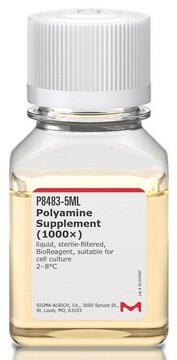R7256
RPMI 1640 Vitamins Solution (100×)
liquid, sterile-filtered, BioReagent, suitable for cell culture
Synonyme(s) :
RPMI 1640 Solution, RPMI 1640 Vitamins, Vitamins Solution
About This Item
Produits recommandés
Stérilité
sterile-filtered
Gamme de produits
BioReagent
Forme
liquid
Technique(s)
cell culture | mammalian: suitable
Impuretés
endotoxin, tested
Couleur
yellow to dark yellow
pH
7.2-7.6
Conditions d'expédition
dry ice
Température de stockage
−20°C
Description générale
Application
- in the preparation of CeM1 medium for the isolation of Caenorhabditis elegans germ cells
- as a component of the amino-acid-deprived medium for the starvation of intestinal porcine enterocytes
- as a component of the stage-8 medium for culturing of human pluripotent stem cell-derived 3D pancreatic progenitor clusters
Code de la classe de stockage
10 - Combustible liquids
Classe de danger pour l'eau (WGK)
WGK 3
Point d'éclair (°F)
Not applicable
Point d'éclair (°C)
Not applicable
Certificats d'analyse (COA)
Recherchez un Certificats d'analyse (COA) en saisissant le numéro de lot du produit. Les numéros de lot figurent sur l'étiquette du produit après les mots "Lot" ou "Batch".
Déjà en possession de ce produit ?
Retrouvez la documentation relative aux produits que vous avez récemment achetés dans la Bibliothèque de documents.
Les clients ont également consulté
Notre équipe de scientifiques dispose d'une expérience dans tous les secteurs de la recherche, notamment en sciences de la vie, science des matériaux, synthèse chimique, chromatographie, analyse et dans de nombreux autres domaines..
Contacter notre Service technique







